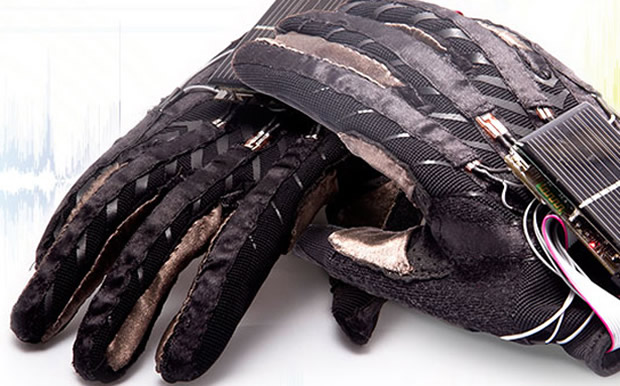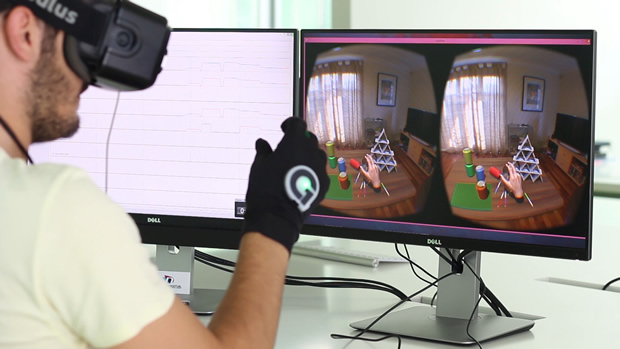Digital Digits
Technological wearables are becoming ever more common in society; starting from their humble beginnings with the Bluetooth headset, branching out to the more eclectic and fashionable, like pet wearables and the Apple watch. Though while wearable tech is becoming more diverse, from goggles to earpieces, there’s one anatomical location more suited for a hands-on approach to tech.
That’s where gloves come in handy. Tech gloves are being developed to encompass a range of uses; research, recreational, utilitarian. Unlike wearables that are independent peripheries, glove tech is far more interactive and dependent on the user. With ten fingers for intricate signalling patterns and two hands for exaggerated spatial movement, the coding combinations are endless. Glove tech has the potential to track the individual extremities and sensitive movements of fingertips, but also the opportunity to track larger hand and arm gestures. From a medical point of view, gloves could also measure temperature and pulse rate. This is how wearable tech and gloves go hand in hand, blindsiding eye tracking technology in comparison.
Translation: Sign-language The University of York’s electronic experts’ approach capitalises this potential for commendable purposes; attempting to break the language barrier and translate sign language into speech. The student team from Ukraine were first-prize winners of the Microsoft Imagine Cup 2012, and their project ‘Enable Talk’ is in the research stages with a functioning prototype. This innovative concept illustrates the potential for glove tech to contribute to improving people’s quality of life.
The University of York’s electronic experts’ approach capitalises this potential for commendable purposes; attempting to break the language barrier and translate sign language into speech. The student team from Ukraine were first-prize winners of the Microsoft Imagine Cup 2012, and their project ‘Enable Talk’ is in the research stages with a functioning prototype. This innovative concept illustrates the potential for glove tech to contribute to improving people’s quality of life.
How does it work? The glove base harnesses a controller on the back of the hand with connecting wires to contact and flex sensors which run down the fingers to the fingertips. This controller then collects all of the information and transmits it to a mobile device with recognition software to translate the movements into speech; which is then in turn is spoken by a computer-generated voice.
Medical research
Movement-sensitive electronic gloves are ‘contributing to major improvements in the monitoring and diagnosis of neurodegenerative conditions likes Parkinson’s disease’ according to experts at the University of York.
Utilising the technology popular with VR gaming and recreational activities, the electronic experts use the gloves to detect hesitations and tremors invisible to the human eye.
Dr Stephen Smith from University of York’s Department of Electronics said: “The introduction of this technology enables nurses to monitor patients at home with results instantly related to consultants.”
The technology is built upon evolutionary algorithms which ‘differentiate between the movements of Parkinson’s patients and age-matched controls,’ according to University of York’s website. They added that, ‘studies have shown the algorithms are more than 90% accurate, a considerable improvement on existing clinical practice’ which is open to human error with data collection reliant upon observation. The tech gloves have proved to me more accurate than the ‘finger tapping test’ to measure the dyskinesia of patients. This glove tech has the potential to change the monitoring process of patients, allowing for patients’ data to be collected remotely and reduce hospital visits.
VR haptics
Funded by Kickstarter, Gloveone goes a step further with virtual reality, and will allow users to ‘touch’ virtual objects, ‘feel’ sound waves, and to differentiate textures.
The tech gloves can be used alongside VR goggles, to combine the sense of sight with haptics. Similarly to EnableTalk, the gloves have a hardware mainboard at the top of the glove. Then there are six IMUs (inertial measurement unit) to ensure full hand and fingers tracking. Alongside tracking the information, the gloves then have vibrotactile actuators for haptic feedback, one for each fingertip and five in the palm. There are also conductive fabric zones in the thumb, index finger, middle finger and palm for command execution. Therefore not only could the gloves act as a smart controller to trigger commands, but could also be used to weight virtual objects and experience virtual reality.
Gloveone’s VR gloves could be the future of interactive VR gaming, and could be a step in ‘E-Health’, as the Gloveone website explains: ‘There are several gaps in healthcare when dealing with visionary solutions like avataring and full presence in Virtual Worlds. Now it is possible thanks to Gloveone.’

Known more for her part in the musical duo Frou Frou, Imogen Heap is part of a non-profit startup ‘mi.mu’ whose ‘aim is to break down the barriers between musicians and machines, and between performers and audiences.’
With a skilled team, mi.mu have created ‘mi.mu Gloves’; musical gloves that are smart controllers to create music with your hands. ‘Imagine, for example, that instead of turning up a fader in order to bring in a sound or add reverb, you could be raising your arms to achieve the same effect,’ as the mi.mu website explains.
The WiFi enabled gloves combine hard-tech and soft-tech, and are a ‘fusion of traditional textiles and advanced motion tracking electronics and algorithms.’ The gloves collect data from the movements made and this information is mapped to musical control messages which are then in turn translated through music software.
Features include:
- Motion tracker
- Haptic motors
- Bend sensors
- LED
- X-OSC
- Textiles
Heap’s gloves won the Wearable IT award 2015, and are available for purchase at £2,500 per glove, but are currently sold out. Watch the interview below with Imogen Heap, as she explains in depth, how the musical gloves operate, and their potential for the music industry.










